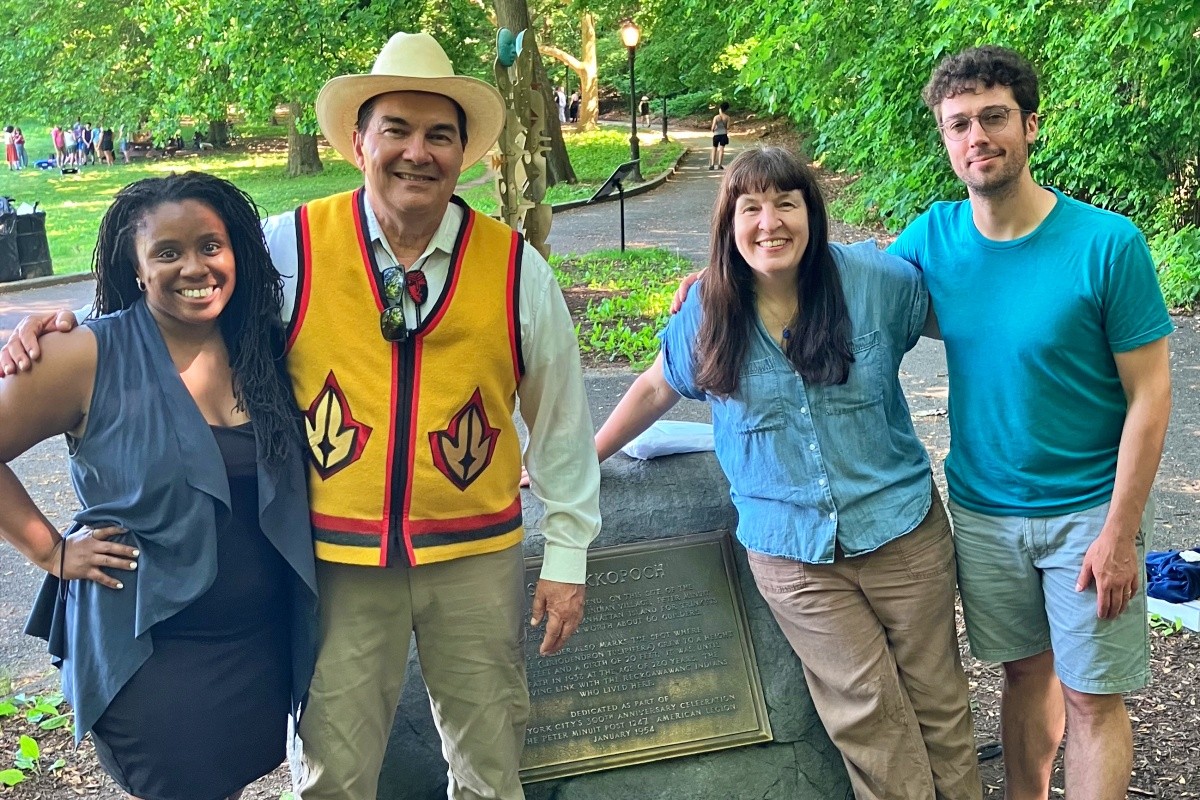When TC's Rachel Talbert asked Lenape Center leaders Joe Baker, Executive Director and Co-founder, and Hadrien Coumans, Deputy Director and Co-founder, how she could support the Center’s mission, their response was clear: create an inclusive, engaging curriculum about the Lenape people. Through collaboration with Talbert and her students, they developed a curriculum highlighting Lenape history and futurity along with current challenges.
“The curriculum’s impact has been profound,” shares Talbert, a Spencer Postdoctoral Fellow in TC’s Curriculum and Teaching department. She worked with Baker and Curtis Zunigha, Co-director and Co-founder of the Lenape Center to launch the free curriculum in 2023. Since then, multiple professional development opportunities have been hosted through TC's Office of Teacher Education (OTE) to support teacher engagement with the curriculum.
The free curriculum highlights the Lenape presence in New York City and helps educators teach their history, fostering inclusivity. “Younger students enjoy learning Lenape words and songs, while high schoolers deepen their understanding of Lenape history and contemporary issues,” Talbert explains.
“Language connects us to our identity, ancestors, clans, and the land,” adds Zunigha. “Reclaiming it is a step toward healing and honoring those who preserved our culture.”
Now as students explore this material, we invited teachers to share their reflections on incorporating the Lenape curriculum in their classrooms.
Meet Gabriella Grinwald-Alves (M.A. '23 ), Director of Transformative Justice Education at Start: Empowerment

How She Makes an Impact in the Classroom: Our curriculum centers on the question, "How can we make these lessons transformative by highlighting Lenape survivance?" We felt it necessary to center Indigenous wisdom while showing students that the Lenape are still here and hold lessons and traditional ecological knowledge that connect to the Lenape language. I worked closely with Curtis Zunigha, who helped me film two short educational video lessons for K-2nd grade students along with lesson plans teachers could use to set up and supplement the video.
What She’s Learned So Far: We are utilizing Lenape language within the curriculum to connect students to the land they live on in a new and profound way. By speaking the Lenape language on Lenape land and hearing from Lenape elders (and hopefully Lenape youth in the future), students can begin to recognize the deep connections the Lenape have to these spaces and natural beings.
Meet Chris Whitney, Pre-K Teacher

How He Makes an Impact in the Classroom: My students have the opportunity to hear from Lenape people about their history and culture, which is different from the traditional classroom curriculum because it centers the Lenape as a people who are not relegated to the past but instead a people with a living and vibrant culture that will continue.
What He’s Learned So Far: I’m grateful for this curriculum because students and teachers can learn about their culture and history from the Lenape people. I have walked away with a better understanding of Lenape culture and history, especially regarding the language. This curriculum sparked my interest in learning more Lenape words for plants and animals.
Meet Chelsea Sue, Second-Grade Teacher

How She Makes an Impact in the Classroom: The Lenape curriculum has been critical in helping my young students understand the Lenape people. For my class, teaching students the eight Lenape Laws resonated with them, and they connected current events and their lives to the laws the Lenape live by. This curriculum makes room for new teaching methods through articles, videos, group work and discussion.
What She's Learned So Far: Previously, I taught in a way that focused primarily on the past. Attending the TC workshops and presentations reoriented that manner of teaching for me. It reframed my mindset so that when teaching about the histories of the Lenape people, I do so through a lens of sharing about people that still are present and active today.
Meet Liz Vassallo, Current Ph.D. Student, Michigan State University

How She Makes an Impact in the Classroom: The curriculum challenges teachers to move away from stereotypes and misconceptions of Indigenous peoples as static or as a single monolithic group and encourages students to form a broader understanding of the role of Indigenous peoples in the past and present. Teaching this way allows me to emphasize the presence of Indigenous peoples in our local communities, which differs significantly from the traditional classroom curriculum that only emphasizes the study of Indigenous communities as cultural groups frozen in the past.
What She’s Learned So Far: Centering concepts like the diversity of Indigenous peoples, their vast contributions to society and their ongoing presence in the United States is essential to transformative teaching. Though it is only a starting point, the Lenape curriculum provides critical guidance about the big ideas that can and should be centered in our teaching of Indigenous peoples.
Exploring Lenape Curriculum: Helpful Resources
- Learn more about the Lenape Center
- Watch Now: Back to Manahatta: The Return of the Lenape
- Download the Manahatta Lenape Center Curriculum





